
Edgar Allan Poe (January 19, 1809 – October 7, 1849) was one of the most famous of the Gothic writers that came about at the end of the American Renaissance. Famous for his short stories and poetry about murders and mystery such as “The Fall of the House of Usher” and “The Raven,” his literary criticism and journalistic pieces, which were his major source of income, are often forgotten.[1] His criticism, contrary to his contemporaries, focused on how style and construction contributed to a work’s effectiveness or failure.[2] Poe’s short stories and poems inarguably employ the very formalist techniques he highlights in his academic works.
Normally associated with Baltimore, where he lived off-and-on, Poe also had a considerable stay in New York City. After being expelled from West Point in 1931, he moved to the city to publish his third collection of poems, simply titled Poems, satirically dedicated to his former classmates.[3] Within a year, he relocated to Baltimore, where he lived with his aunt and her daughter, Virginia. He subsequently moved to them both Richmond and took his cousin as his bride.[4]
Poe did not return to New York for his longer stint in the city until 1844. Shortly after his arrival, Poe wrote and published “The Raven” in January 1845. He and Virginia moved around Manhattan for two years while he gave lectures and tried to run a magazine, The Broadway Journal.[5] When the magazine and Virginia’s health both declined, Poe and his wife took up residence in pastoral Fordham Village, now the Bronx. While there, he wrote one of his most famous poems, “Annabel Lee,” as well as “The Bells” and the short story “The Cask of Amontillado.”[6][7] Virginia died in late 1847, but Poe remained at his cottage until 1849. Indeed, his final years were spent in New York, only going to Baltimore a few months before dying.
Edgar Allan Poe Cottage

Edgar Allan Poe Cottage is located in Poe Park, at Kingsbridge Road and the Grand Concourse in the Bronx. It was built in 1812 as a working house, but served as “bucolic” retreat from the surrounding city for Poe.[8] From Poe’s death until the 1890’s, Poe Cottage grew dilapidated and even faced demolition. However, preservation groups and the building’s owner worked together to eventually relocate the farmhouse to a constructed park, Poe Park, in 1913. As the only surviving home from early-19th century Fordham, author for Smithsonian.com Jimmy Stamp brings forth that Poe Cottage is “a testament to preservation – not only of Poe’s history, but of New York’s history”.[9] Poe Cottage is not short on history or innovation: it was meticulously restored in 2011 in addition to the construction of a new, raven-shaped visitor center.

Fun Facts:
- In addition to his namesake park and cottage, Edgar Allan Poe has a street bearing his name in the Upper West Side (also marked as 84th Street), a few blocks from his bust at Columbia University.
- The Baltimore Ravens are so named for Poe’s work, even if it wasn’t written in Baltimore. The three mascots are named Edgar, Allan, and Poe, respectively.
Analysis of “The Doings of Gotham” by Alexander Grey
Within his letters “The Doings of Gotham,” Poe takes care to point out every fault he sees in New York, no matter how minute, to present an accurate view of a city that is relatively unknown to much of the nation at the time. While Poe does tend into the realm of the mundane as he gripes at length about the necessity of moving to a wood-paved street (Poe 103), he seems to have far more substance to his arguments. Indeed he sees the creation of small non-houses in Brooklyn as akin to “blowing up a House of Parliament,” (103) and that the impression of new Sunday-specific laws are “in palpable violation of the Constitution” (97).
In Poe’s presentation of New York, it seems the inhabitants always go further down this road of ignorance presented, until they are completely absorbed in the vanity of whatever trend is in vogue or with the gossip of the street. These people have completely forgotten the ability to see the world around them objectively, simply creating, without regard to their effect on the geography (as he argues in the construction of new streets and the building of ports) because they are too absorbed with themselves. Indeed the whole collected letters seem to be but filled with anger over the people he must interact with, which seems it stay in line with the dark and depressing image of Poe that current readers hold, proving that even when not writing his darker stories, Poe is a Gothic to the end.
Poe, Edgar Allan. “From: Doings of Gotham.” Writing New York:A Literary Anthology. Ed. Phillip Lopate. 10th ed. New York: Library of America, 2008. 90-106. Print.
Analysis of “The Cask of Amontillado” by Mary Cramer
In contrast to “The Doings of Gotham”—a poem written by Poe about New York while he resided in Baltimore—“The Cask of Amontillado” was penned during Poe’s time in city, but its setting transcends any colonial domain Poe visited. However, his feelings about society are similarly expressed in his thoughtful choice of placing the narrative within a vague, carnival counter-society wherein law and reason yield to fantasy. The circumstances of Fortunato’s drunk inhibitions and Montressor’s dubious plan could not have come to fruition within the constraint’s of colonial New York society. To start, a rich and powerful man would never willingly assume the guise of a fool; American foolishness is blind and arrogant. Moreover, New York as portrayed by Poe in “Gotham” is a society of greed and turmoil wherein all fantasies are crushed. Considering the failure of his business, the death of his wife, and the decline of his own state within in New York, it is unsurprising Poe would continue to demonize the urban city during his time there.
Montressor’s act of leading Fortunato to his death underscores Poe’s desires for an existence free from society’s judgements and restrictions. His plan is one of revenge wherein he exacts the final judgement (and restrictions) upon Fortunato. Compounding the subversion of society further, is the scene wherein Fortunato invokes the Freemasons to which Montressor presents a masonry trowel. This clever inclusion at once illuminates a counterculture, the Masons, but also establishes yet another society from which Montressor is excluded. As such, when Montressor assaults Fortunato, he is also attacking what Fortunato stands for: the successful society man. In taking advantage of Fortunato’s carnival identity—indulgent, uninhibited, trusting—Poe’s antihero is able to exact his revenge against the judgmental, pretentious identity Fortunato symbolizes in his reality. Thus, the murder of Fortunato frees Montressor not only from the literal torments of the deceased, but more so, of his own powerlessness within traditional society.
Poe, Edgar Allan. “The Cask of Amontillado.” Edgar Allan Poe Society of Baltimore, www.eapoe.org/works/reading/pt063r1.htm.
Poe’s New York Bibliography
Poems (Published but not written in New York) – 1831
“The Raven” – 1845
“The Cask of Amontillado” – 1846
“Eureka: A Prose Poem” – 1848
“The Bells” – 1849
“Annabel Lee” – 1849
References
Meyers, Jeffrey. Edgar Allan Poe: His Life and Legacy. Cooper Square Press, 2000.
“Poe’s Biography.” Poe Museum, Poe Museum, https://www.poemuseum.org/poes-biography.
Stamp, Jimmy. “When Edgar Allan Poe Needed to Get Away, He Went to the Bronx.” Smithsonian.com, Smithsonian Institution, 28 Jan. 2014, www.smithsonianmag.com/arts-culture/when-edgar-allan-poe-needed-to-get-away-he-went-to-the-bronx-180949454/.
“Edgar Allan Poe in the Bronx.” Bronx Historical Society, Bronx Historical Society, http://bronxhistoricalsociety.org/poe-cottage/.
“The Collected Works of Edgar Allan Poe.” Edgar Allan Poe Society of Baltimore, Edgar Allan Poe Society of Baltimore, www.eapoe.org/index.htm.
Contributors: Alexander Grey and Mary Cramer